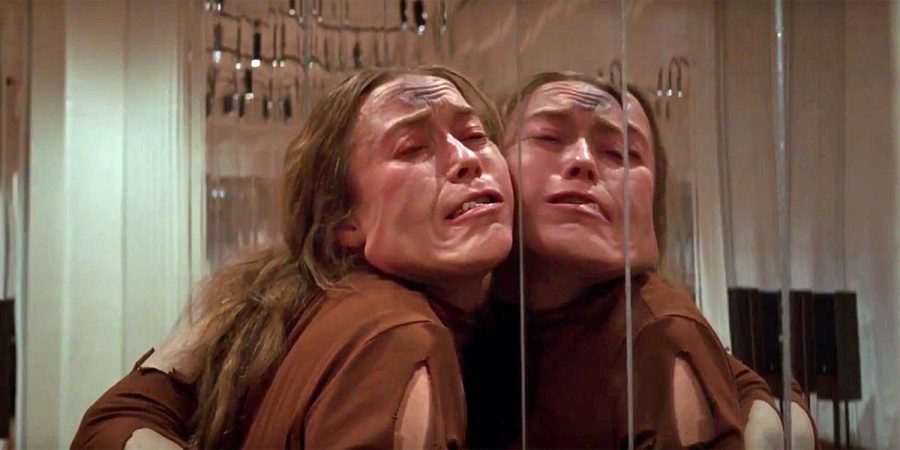Tremble, tremble, the witches are back with Luca Guadagnino’s reimagining of the technicolor nightmare “Suspiria.” Less of a remake and more of a cover, “Suspiria” is a disgustingly beautiful ode to Dario Argento’s 1979 horror opus and his sinister coven of witches in leotards and tights.
The first thing you’ll notice is an emotionally distraught Patricia (Chloe Grace Moretz) making her escape from the Helena Markos Dance Company. Backdropped against a politically distraught Berlin (see the German Autumn of 1977), the traumatized dancer makes her way to psychoanalyst Dr. Jozef Klemperer, played inconspicuously by the genderbending Tilda Swinton. Patricia claims the directors of the company are plotting against her and will “hollow me out and eat my c-nt on a plate.” And thus, “Supiria” begins.
If you can’t stomach body horror of the most nauseating proportions, I recommend you sit this one out and vouch for “Beautiful Boy” instead. What follows is two and a half hours of unrelentless gore and tantalizing terror.
After introductions are over — you won’t see much of Patricia again — the film transitions to a brighter, more hopeful day. Wide-eyed Suzy Bannion (Dakota Johnson) makes her way from Ohio to vie for a spot in the company. Her audition immediately captivates the faculty in both earthly and supernatural ways, especially headmistress Madam Blanc — also played by Tilda Swinton. The company welcomes Suzy with open arms, and rehearsals ensue as planned until an underlying presence envelops Suzy and a few other unlucky dancers.
The nuanced plot that drives “Suspiria” would take essays to explain, but essentially, the coven is looking for a dancer — or vessel — to carry on the spirit of the company’s founding witch, Helena Markos. As Suzy and Blanc grow closer in and out of the studio, the headmistress comes to find that the American dancer could be the young, healthy body they’ve been searching for. But do you think Guadagnino was going to let the audience leave his film with such a simple plot? Instead, interspersed between shots of the red-hued rehearsal space and bleak, war-torn Berlin, audiences witness fever dreams of bloody hooks and dismembered bodies, the torture of mischievous dancers and a final act so graphically barbarous, Guadagnino chose to shoot it with a permanent red overlay as to lighten the load of blood and guts that pierces the screen.
Premiering at the 75th Venice International Film Festival earlier this year, “Suspiria” received polarizing notices from critics a la Darren Aronofsky’s “mother!” Some criticized its unfaithful adaptation of the original while others praised its refreshing color palette, score and reinvigoration of the low-budget original. After viewing it myself, I found the new version to be one of the most captivating and deeply effective pieces of cinema in recent years.
The goal of cinema isn’t always to impact you directly in your seat, but rather follow you out of the theater and slowly sink its hooks into your daily life. With “Suspiria,” there is obvious shock value in the film that will satisfy your surface level viewing pleasures, but for those looking deeper, you will leave the theater grappling with a variety of themes.
Despite the violence depicted, “Suspiria” is a feminist film at its core. The nearly all-female cast and the setting of the film explore the collective power of women and the inexorable bond of sisterhood — whether that be saccharine or sentimental. On a smaller scale, it explores the symbiosis between sacrifice and art and the awry costs that can come with losing yourself to your craft.
To fans of Argento’s “Suspiria,” this version is a stark contrast from the original both in style and in plot. All that Guadagnino keeps is character and setting, but he begins completely anew with the story. David Kajganich’s screenplay works to explore the foundations of the coven that the original glossed over in favor of style. In doing so, Kajganich explores how an event like this would really happen and how bystanders to the supernatural would naturally respond. Whether it be through dialogue or Guadagnino’s direction, the performances that permeate “Suspiria” are of the highest quality. And for those who’ve seen the “Fifty Shades” trilogy, Dakota Johnson’s performance is quite unsuspecting.
An absolute knockout in her portrayal of Suzy, Johnson proves herself to be more than just a sex symbol for mainstream fare. She brings an air of naivete and innocence to the sexually frustrated, formally anabaptist dancer. The way Johnson speaks and moves is unbelievably lived-in. She is Suzy Bannion. Mia Goth, Chloe Grace Moretz and Elena Fokina are all excellent in their supporting roles. Goth, in particular, deserves an accolade or two for her bloodcurdling scream at the film’s climax.
But the true MVP is Tilda Swinton. Her performance as the maternal, masochistic Madame Blanc is further proof that the U.S. does not deserve the British thespian. Doubling as both Blanc and Dr. Klemperer behind a thick coat of makeup and prosthetics, Swinton is the ultimate standout of the film. (I would go as far as to call “Suspiria” her film.) She masters both the ethos of a ballet mistress in decline and a paranoid old man like a lap around the park. She carries “Suspiria” on her back and never shies from the pressure. Aside from her articulation and line delivery, Swinton’s physical presence onscreen is a force of its own. You can’t help but ignore everyone else when Blanc enters the studio in a medieval-like smock and a cigarette in hand.
In one noteworthy exchange between Swinton and Johnson, the former explains that art can never be cheerful or beautiful. “We must crush the noses of everything beautiful,” Swinton rejoices. If one line of dialogue serves as the thesis for the film, this would be it. “Suspiria” is far from beautiful. It is dark, nasty and unrelentingly graphic in nature, but I wouldn’t want it any other way. Don’t let these words scare you away. But be warned: this is not a walk in the park, but rather a blood-soaked road trip through the darkest realms of hell.
A version of this article appeared in the Monday, Oct. 22 print edition. Email Ryan Mikel at [email protected].
























































































































































